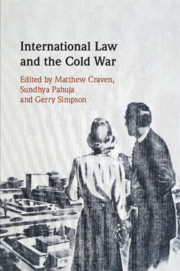Book contents
- International Law and the Cold War
- International Law and the Cold War
- Copyright page
- Dedication
- Contents
- Figures
- About the Editors
- About the Authors
- Acknowledgements
- 1 Reading and Unreading a Historiography of Hiatus
- Part I The Anti-linear Cold War
- Part II The Generative/Productive Cold War
- 4 Accounting for the ENMOD Convention: Cold War Influences on the Origins and Development of the 1976 Convention on Environmental Modification Techniques
- 5 Nuclear Weapons Law and the Cold War and Post–Cold War Worlds: a Story of Co-production
- 6 Parallel Worlds: Cold War Division Space
- 7 Shadowboxing: The Data Shadows of Cold War International Law
- 8 Contesting the Right to Leave in International Law: the Berlin Wall, the Third World Brain Drain and the Politics of Emigration in the 1960s
- 9 Bridging Ideologies: Julian Huxley, Détente, and the Emergence of International Environmental Law
- 10 More than a ‘Parlour Game’: International Law in Australian Public Debate, 1965–1966
- 11 Environmental Justice, the Cold War and US Human Rights Exceptionalism
- 12 The Cold War and Its Impact on Soviet Legal Doctrine
- 13 Forced Labour
- 14 Rupture and Continuity: North–South Struggles over Debt and Economic Co-operation at the End of the Cold War
- 15 The Cold War History of the Landmines Convention
- Part III The Parochial/Plural Cold War
- References to Cold War Volume
- Index
13 - Forced Labour
from Part II - The Generative/Productive Cold War
Published online by Cambridge University Press: 05 December 2019
- International Law and the Cold War
- International Law and the Cold War
- Copyright page
- Dedication
- Contents
- Figures
- About the Editors
- About the Authors
- Acknowledgements
- 1 Reading and Unreading a Historiography of Hiatus
- Part I The Anti-linear Cold War
- Part II The Generative/Productive Cold War
- 4 Accounting for the ENMOD Convention: Cold War Influences on the Origins and Development of the 1976 Convention on Environmental Modification Techniques
- 5 Nuclear Weapons Law and the Cold War and Post–Cold War Worlds: a Story of Co-production
- 6 Parallel Worlds: Cold War Division Space
- 7 Shadowboxing: The Data Shadows of Cold War International Law
- 8 Contesting the Right to Leave in International Law: the Berlin Wall, the Third World Brain Drain and the Politics of Emigration in the 1960s
- 9 Bridging Ideologies: Julian Huxley, Détente, and the Emergence of International Environmental Law
- 10 More than a ‘Parlour Game’: International Law in Australian Public Debate, 1965–1966
- 11 Environmental Justice, the Cold War and US Human Rights Exceptionalism
- 12 The Cold War and Its Impact on Soviet Legal Doctrine
- 13 Forced Labour
- 14 Rupture and Continuity: North–South Struggles over Debt and Economic Co-operation at the End of the Cold War
- 15 The Cold War History of the Landmines Convention
- Part III The Parochial/Plural Cold War
- References to Cold War Volume
- Index
Summary
In the early years of the Cold War, important debates took place on the nature and scope of both slavery and forced labour. The adoption of the Supplementary Convention on the Abolition of Slavery in 1956 and the vote on the Convention on the Abolition of Forced Labour in 1957 were preceded by long and heated discussions within key international bodies such as the United Nations Social and Economic Council (‘ECOSOC’) and the International Labour Organization (‘ILO’). Yet, conventional legal histories tend to minimise these debates on the ground that they relate to the ‘political context’ of the Cold War. What is more, they tend to present the adoption of the two conventions as building blocks of the abolitionary project pursued by modern international law. My aim in this chapter is to destabilise such linear narratives. Focusing on the issue of forced labour, I will make five points.
Keywords
- Type
- Chapter
- Information
- International Law and the Cold War , pp. 271 - 286Publisher: Cambridge University PressPrint publication year: 2019

